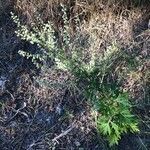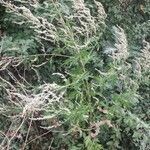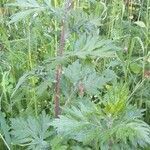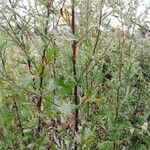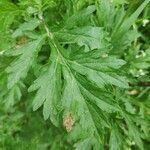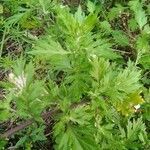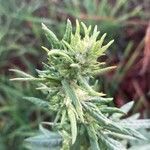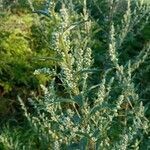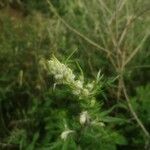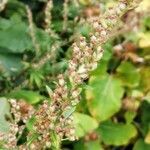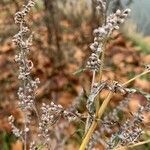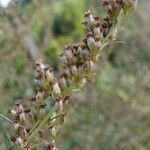Perennials, (40–)60–190 cm, sometimes faintly aromatic (rhizomes coarse). Stems relatively numerous, erect, brownish to reddish brown, simple proximally, branched distally (angularly ribbed), sparsely hairy or glabrous. Leaves basal (petiolate) and cauline (sessile), uniformly green or bicolor; blades broadly lanceolate, ovate, or linear, (2–)3–10(–12) × 1.8–8 cm (proximal reduced and entire, distal pinnately dissected, lobes to 20 mm wide), faces pubescent or glabrescent (abaxial) or glabrous (adaxial). Heads in compact, paniculiform or racemiform arrays (10–)20–30(–40) × (5–)7–15(–20) cm. Involucres ovoid to campanulate, 2–3(–4) mm. Phyllaries lanceolate, hairy or glabrescent. Florets: pistillate 7–10; bisexual (5–)8–20; corollas yellowish to reddish brown, 1.5–3 mm, glabrous (style branches arched-curved, truncate, ciliate). Cypselae ellipsoid, 0.5–1(–1.2) mm, glabrous, sometimes resinous. 2n = 18, 36, 40, 54.
Rhizomatous perennial 0.5–2 m, simple or branched above, the stem glabrous or nearly so below the infl; lvs green and glabrous or nearly so above, densely white-tomentose beneath, chiefly obovate or ovate in outline, 5–10 × 3–7 cm, the principal ones cleft nearly to the midrib into ascending, acute, unequal segments that are again toothed or cleft, and ordinarily with 1 or 2 pairs of stipule-like lobes at base; infl generally ample and leafy; invol 3.5–4.5 mm; disk-cors 2.0–2.8 mm; achenes ellipsoid, not nerved or angled; 2n=16. Fields, roadsides, and waste places; native of Eurasia, now established throughout most of e. U.S. and adj. Can. July–Oct.
A shrub which continues to grow year after year. It grows to a height of 1.2 m and spreads to 1.5 m across. The underground root like structure is branched and has a nodular appearance. There are many stems. They are angular with grooves. The stems are red. The leaves are green. The lower leaves have short leaf stalks and teeth like sections. They are downy underneath the leaf. The upper leaves do not have leaf stalks but clasp the stem. The flowers can be greenish yellow or reddish brown. They occur in small oval heads.
Annual or occasional perennial, aromatic herb, up to 0.7 m high. Leaves pinnatifid, auriculate at base, segments sometimes deeply lobed, glabrous and dark green above, whitish tomentose below, lower leaves shortly petiolate, upper sessile. Capitula disciform, many together in terminal panicle. Ray florets female, filiform. Disc florets cylindric, reddish brown. Flowering time Mar. Pappus absent.
